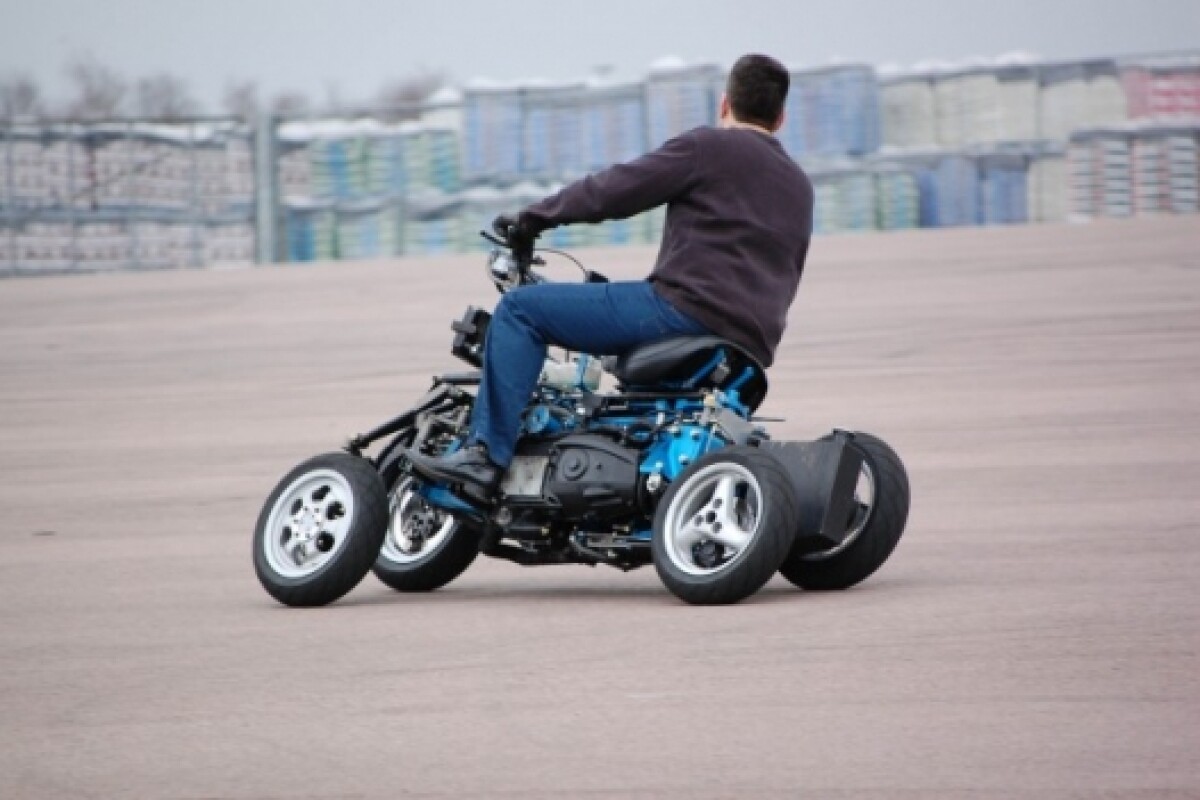MOST tests involve a long process of careful assessment to judge the relative benefits and disadvantages of the bike in question, painstakingly attempting to judge whether the new machine has any clear advantage over its competitors. But on swinging a leg over the only existing 4MC prototype the only question in your mind is answered within seconds.
And the answer is yes; this is still a motorcycle, despite the number of wheels. The 4MC feels as natural to ride as any conventional two-wheeled bike. Blindfolded, you'd swear you were straddling a quite normal big-capacity scooter, so familiar are the handling, the feedback and the controls. And that in itself is perhaps the greatest achievement of this completely new design.
So, if it feels so normal, why bother with the extra wheels? To discover that, you really need to get into a situation that you never want on a normal bike; a big, unexpected slide of the front or rear end. Because on the 4MC that slide either simply won't happen, or if it does the bike will mollycoddle you through it, proving virtually impossible to fall off. It's little short of remarkable – in tests on a oil-covered skid-pan that would see any rider, on any conventional bike, picking themselves off the ground within seconds, the 4MC doesn't just remain upright, but it can actually cope better with the slippery conditions than most cars – as proved by skid-pan lap-times several seconds faster than most cars can manage on the same circuit. There are no bike times to compare it with; no two-wheeler has been tested that can safely make a single lap on the low-friction surface.
As a prototype, there's little point in going into the finer points of the 4MC's handling; it feels relatively long, with a low center of gravity disguising it's overall weight, and it's set up to give neutral handling. Only when you tip it over at ultra-low speed do you realize that, with the fear of crashing surgically removed, you can make full-lean, low speed circles tighter than you're ever likely to dare on a conventional bike.
More important than the handling – which on this prototype is so hugely adjustable that it's virtually immaterial anyway – is the feedback. Bumps are something you notice, but which don't upset the bike – even if you hit one with just one wheel during a tight turn, it does nothing to throw the machine off line. And at the bars there's exactly the feeling you'd expect from normal forks, with none of the remoteness usually associated with hub-center steered two wheelers – a result of a its designer's own concoction of play-free joints in the steering system.
So, it works. But why? Is it a bike? Is it a quad? Is it a car? As far as most governments are concerned, it's none of them – despite the mathematical evidence against it, they reckon it's a trike, and that's exactly why it's got the potential to be the most significant thing in motorcycling for years. Under the licensing laws of most countries, a machine like this can be ridden using a normal car driving licence, so its potential market is far, far bigger than any normal bike can dream of. In most developed countries, bike licence holders are outnumbered at least 15-1 by car drivers, and often the ratio is far greater. That means the 4MC's pool of potential buyers is simply enormous.
And thanks to its four-wheeled design and ingenious suspension system, which means it can go to full lean, complete with a rider, without falling over even at a standstill, it's got the extra element of safety that could tempt drivers who'd never dare venture onto two wheels. It's no wider than the average bike, so it can still slice through traffic, and it's bike-derived engine – a Yamaha YP400 scooter motor in the prototype – means its fuel economy is just as good as a two-wheeler's.
And its designer, Nick Shotter, isn't the only person to have spotted that this sort of bike could take off. Piaggio's three-wheeled MP3 scooter is already a huge success, and the firm has recently revealed a fractionally wider version that uses the same licence loophole as the MC4 to allow car drivers to use it without any extra training or testing. And Yamaha's 2007 Tokyo Show concept bike, the Tesseract, revealed how a future superbike using Shotter's suspension concept could look. Before that bike was built, Shotter had already approached Yamaha with his designs, and Yamaha Japan is in direct contact with him regarding the suspension layout; if they want to put the Tesseract into production, they'll need to licence the suspension technology from Shotter, who owns the patents on the layout.



























